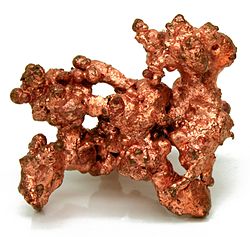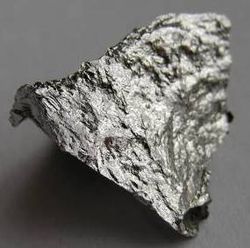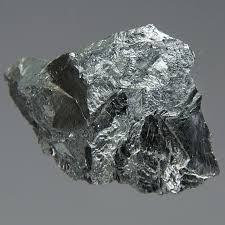Cu
Copper is a chemical element with the symbol Cu (from Latin: cuprum) and atomic number 29. It is a ductile metal with very high thermal and electrical conductivity. Pure copper is soft and malleable; a freshly exposed surface has a reddish-orange color. It is used as a conductor of heat and electricity, a building material, and a constituent of various metal alloys.

Its compounds are commonly encountered as copper(II) salts, which often impart blue or green colors to minerals such as azurite and turquoise and have been widely used historically as pigments. Architectural structures built with copper corrode to give green verdigris (or patina). Decorative art prominently features copper, both by itself and as part of pigments.
Mg
Manganese is a chemical element, designated by the symbol Mn. It has the atomic number 25. It is found as a free element in nature (often in combination with iron), and in many minerals. Manganese is a metal with important industrial metal alloy uses, particularly in stainless steels.

Manganese phosphating is used as a treatment for rust and corrosion prevention on steel. Depending on their oxidation state, manganese ions have various colors and are used industrially as pigments. The permanganates of alkali and alkaline earth metals are powerful oxidizers. Manganese dioxide is used as the cathode (electron acceptor) material in zinc-carbon and alkaline batteries.
Cr
Chromium is a chemical element which has the symbol Cr and atomic number 24. It is the first element in Group 6. It is a steely-gray, lustrous, hard and brittle metal which takes a high polish, resists tarnishing, and has a high melting point. The name of the element is derived from the Greek word χρῶμα, chrōma, meaning colour, because many of its compounds are intensely coloured.

Chromium metal and ferrochromium alloy are commercially produced from reactions, or by roasting and leaching processes. Chromium metal has proven of high value due to its high corrosion resistance and hardness. A major development was the discovery that steel could be made highly resistant to corrosion and discoloration by adding metallic chromium to form stainless steel. This application, along with chrome plating currently comprise 85% of the commercial use for the element, with applications for chromium compounds forming the remainder.
Copper is a chemical element with the symbol Cu (from Latin: cuprum) and atomic number 29. It is a ductile metal with very high thermal and electrical conductivity. Pure copper is soft and malleable; a freshly exposed surface has a reddish-orange color. It is used as a conductor of heat and electricity, a building material, and a constituent of various metal alloys.

Its compounds are commonly encountered as copper(II) salts, which often impart blue or green colors to minerals such as azurite and turquoise and have been widely used historically as pigments. Architectural structures built with copper corrode to give green verdigris (or patina). Decorative art prominently features copper, both by itself and as part of pigments.
Mg
Manganese is a chemical element, designated by the symbol Mn. It has the atomic number 25. It is found as a free element in nature (often in combination with iron), and in many minerals. Manganese is a metal with important industrial metal alloy uses, particularly in stainless steels.

Manganese phosphating is used as a treatment for rust and corrosion prevention on steel. Depending on their oxidation state, manganese ions have various colors and are used industrially as pigments. The permanganates of alkali and alkaline earth metals are powerful oxidizers. Manganese dioxide is used as the cathode (electron acceptor) material in zinc-carbon and alkaline batteries.
Cr
Chromium is a chemical element which has the symbol Cr and atomic number 24. It is the first element in Group 6. It is a steely-gray, lustrous, hard and brittle metal which takes a high polish, resists tarnishing, and has a high melting point. The name of the element is derived from the Greek word χρῶμα, chrōma, meaning colour, because many of its compounds are intensely coloured.

Chromium metal and ferrochromium alloy are commercially produced from reactions, or by roasting and leaching processes. Chromium metal has proven of high value due to its high corrosion resistance and hardness. A major development was the discovery that steel could be made highly resistant to corrosion and discoloration by adding metallic chromium to form stainless steel. This application, along with chrome plating currently comprise 85% of the commercial use for the element, with applications for chromium compounds forming the remainder.